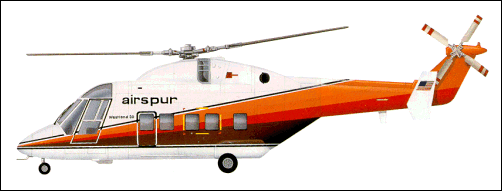
| Westland 30 |  |
 |

| Westland 30 |  |
 |
|
The origins of the Westland 30, originally known as the WG-30 Super Lynx, go back to the sixties, when Westland was studying the possibility of a replacement for the Wessex and Whirlwind which were then in service with various civil and military operators. After considering a civil version of the Lynx, the British company favoured a larger machine using many of the components of the military helicopter. Accordingly, the Westland 30 has the transmission, rotor blade structure, some systems and many instruments and accessories of the Lynx, but the fuselage is entirely new and is bigger, even if it resembles the Lynx aerodynamically. It is made wholly of aluminum with a traditional type of structure and skin, while composite materials are used in the tail boom. The landing gear is fixed and the main units are housed in two fairings at the sides of the aft fuselage. The fuel system comprises two 630 liter tanks in the fuselage. The hydraulic system is similar to that of the Lynx as is the instrument panel with a few additions. The larger rotor should have a much longer service life than that of the Lynx on account of its slower rotational speed. Care has been taken to reduce vibrations in the fuselage. The Westland 30 was originally intended for military use in the tactical transport and air ambulance roles, but the design has proved equally suitable for the civil market. In this role, the helicopter is approved for instrument flight, has optional airstair or sliding doors, and can take up to 22 passengers in the high density version in a comfortable, soundproofed cabin. Behind the cabin, which can be furnished to customers' requirements to carry VIPs, executives or freight, there is an ample baggage compartment reached from the rear of the fuselage. The capabilities of the Westland 30 for offshore work are particularly interesting: with a 250km radius of action and 227kg fuel, the initial W30-100 variant can carry nine passengers on the outward journey and 13 on the homeward one. This type has been ordered by British Airways. In the military version, the same aircraft can carry 14 equipped troops or 17 without equipment, or six stretchers plus medical attendants. The prototype of the Westland 30 made its first flight on 10 April 1979 in time for a successful appearance at the Paris Air Show that year. Production and delivery of W30-100 aircraft began in 1981. This version has now been superseded by the W30-160 with uprated Gem 60 engines. Westland is also now test-flying the W30-200 prototype, powered by 1700shp General Electric CT-7 engines, which are expected to much improve gross weight performance and payload in hot/high countries, and is also developing a new five-blade rotor system which is expected to appear on yet another new variant, the W30-300. G.Apostolo "The Illustrated Encyclopedia of Helicopters", 1984
Under the designation Westland 30 (initially WG 30), the company developed an enlarged, twin-engined transport version of the Lynx, beginning in 1976. Westland foresaw a market for the type in VIP, passenger and cargo transport, and off-shore support operations. The first aircraft (G-BGHF) flew on 10 April 1979. CAA and FA A type certification of the basic production version, the Series 1OO, powered by a pair of 846kW Rolls-Royce Gem Mk 41-1 turboshafts, was granted in 1982. Compared to the Lynx, the Westland 30 featured a greatly increased cabin coupled with a larger rotor, increased fuel capacity and a new flight control system. In January 1984 the Series 100-60 appeared, powered by two 940kW Gem 60-3 engines. Rolls-Royce was replaced by General Electric in the Series 200, which was powered by a pair of 1277kW CT7-2B engines. This version first flew in 1983. The Series 300 of 1986 offered a General Electric CT7 or Rolls-Royce Turbomeca RTM 322 powerplant, and also had an increased maximum take-off weight, composite BERP rotor blades, considerably reduced noise and vibration levels and an optional EFIS cockpit. Two military tactical transport versions were also developed, the TT30 and the TT300, but these met with even less success than the civilian versions. British Airways ordered two helicopters, for delivery in 1982, and obtained a third the following year. Sixteen further aircraft were spread among several operators in the United States, such as PanAm/Omniflight (for services between John F. Kennedy, Newark and downtown New York) and Airspur. These aircraft were largely Series 100s and 100-60s, operated on lease. By early 1984 only 19 orders had been received. In 1986 the Westland 30 received its last, and largest, order for 21 Series 100-60s from the Helicopter Corporation of India, financed largely by UK government assistance. Production ended in January 1988 with the completion of the 38th airframe. The Helicopter Corporation of India became Pawan Hans and its 19 surviving Westland 30-160s are stored at Delhi and Bombay, the company having failed to sell them on several recent occasions. D.Donald "The Complete Encyclopedia of World Aircraft", 1997 
|